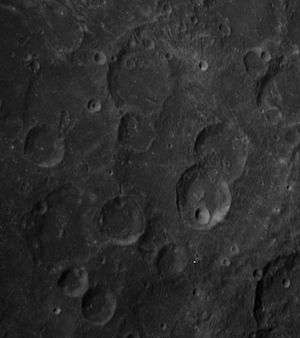Ginzel (crater)
 Ginzel crater and its satellite crater Ginzel L to the south, on the bottom right, a tiny portion of the satellite craters in shade Ginzel G and H are rarely seen with its shade | |
| Coordinates | 14°18′N 97°24′E / 14.3°N 97.4°ECoordinates: 14°18′N 97°24′E / 14.3°N 97.4°E |
|---|---|
| Diameter | 55 km |
| Depth | Unknown |
| Colongitude | 263° at sunrise |
| Eponym | Friedrich K. Ginzel |
Ginzel is a lunar impact crater that is located on the far side of the Moon, just beyond the eastern limb. It is named after the Austrian astronomer Friedrich Karl Ginzel. It lies at the eastern edge of the Mare Marginis, in a region of the surface that is sometimes brought into sight of the Earth due to libration. To the north-northeast of Ginzel is the crater Popov, and Dreyer lies due south.
Much of the rim and interior of Ginzel have been flooded, leaving only a faint trace of the rim in the otherwise relatively level surface. The western rim projects more prominently above the surrounding irregular plain. The flooded satellite crater Ginzel L is attached to the southern part of the rim, and a small craterlet lies across the rim to the north. Within the interior is a pair of joined small craterlets in the western half. The interior is otherwise nearly featureless.
Satellite craters
By convention these features are identified on lunar maps by placing the letter on the side of the crater midpoint that is closest to Ginzel.
| Ginzel | Latitude | Longitude | Diameter |
|---|---|---|---|
| G | 13.7° N | 100.2° E | 42 km |
| H | 12.7° N | 100.1° E | 50 km |
| L | 13.1° N | 97.8° E | 28 km |
References
- Andersson, L. E.; Whitaker, E. A. (1982). NASA Catalogue of Lunar Nomenclature. NASA RP-1097.
- Blue, Jennifer (July 25, 2007). "Gazetteer of Planetary Nomenclature". USGS. Retrieved 2007-08-05.
- Bussey, B.; Spudis, P. (2004). The Clementine Atlas of the Moon. New York: Cambridge University Press. ISBN 978-0-521-81528-4.
- Cocks, Elijah E.; Cocks, Josiah C. (1995). Who's Who on the Moon: A Biographical Dictionary of Lunar Nomenclature. Tudor Publishers. ISBN 978-0-936389-27-1.
- McDowell, Jonathan (July 15, 2007). "Lunar Nomenclature". Jonathan's Space Report. Retrieved 2007-10-24.
- Menzel, D. H.; Minnaert, M.; Levin, B.; Dollfus, A.; Bell, B. (1971). "Report on Lunar Nomenclature by the Working Group of Commission 17 of the IAU". Space Science Reviews. 12 (2): 136–186. Bibcode:1971SSRv...12..136M. doi:10.1007/BF00171763.
- Moore, Patrick (2001). On the Moon. Sterling Publishing Co. ISBN 978-0-304-35469-6.
- Price, Fred W. (1988). The Moon Observer's Handbook. Cambridge University Press. ISBN 978-0-521-33500-3.
- Rükl, Antonín (1990). Atlas of the Moon. Kalmbach Books. ISBN 978-0-913135-17-4.
- Webb, Rev. T. W. (1962). Celestial Objects for Common Telescopes (6th revised ed.). Dover. ISBN 978-0-486-20917-3.
- Whitaker, Ewen A. (1999). Mapping and Naming the Moon. Cambridge University Press. ISBN 978-0-521-62248-6.
- Wlasuk, Peter T. (2000). Observing the Moon. Springer. ISBN 978-1-85233-193-1.
| Wikimedia Commons has media related to Ginzel (lunar crater). |
